
L-R: Claudia Li, Linda Moya, Eve Ayar, Syan Lopez, Hunsica Jayaprakash, Madelyn McAndrew, Esther Bedoyan, Noah Hillman, Harold Rockwell, Jessica Weber, Laila Johnston, Elizabeth Chamiec-Case, Evan Weiss, Casey Weiner, Manuel Alvarez-Rios, Nicholas Blauch, Darryl Badley, Hannah Douglas, Matthew Clapp, Lauren Lang.
Below is the 2020 Summer Undergraduate Research Program in Neuro Computation (uPNC) class roster. Selecting the name of the student will take you to a short description the the student’s research and links to their poster and research introduction video.- Manuel Alvarez-Rios
- Eve Ayar
- Darryl Badley
- Esther Bedoyan
- Elizabeth Chamiec-Case
- Hannah Douglas
- Noah Hillman
- Hunsica Jayaprakash
- Laila Johnston
- Lauren Lang
- Claudia Li
- Syan Lopez
- Madelyn McAndrew
- Harold Rockwell
- Jessica Weber
- Casey Weiner
- Evan Weiss
Manuel Alvarez-Rios
 Undergraduate Institution: University of Puerto Rico
Mentor: Yorie Nakahira
University and Department: Carnegie Mellon University, Electrical and Computer Engineering
Project Description: Manuel Alvarez-Rios and his mentor first identifed some of the underlying differences between the biological visual systems and computer vision systems in the literature for purposes of using the insights to inspire the development of the new computer vision systems inspired by the biological ones. We proposed utilizing a Convolutional Recurrent Neural Network (ConvRNN), a type of convolutional neural network (CNN) that introduces two architectural features that are present in biological visual systems and not shared with typical Feed-Forward CNNs: local recurrence and long-range feedback. We hypothesize that utilizing ConvRNNs could improve tracking by enabling the reusability and extraction of motion features.
Manuel Alvarez-Rios’s Research Introduction Video
back
Undergraduate Institution: University of Puerto Rico
Mentor: Yorie Nakahira
University and Department: Carnegie Mellon University, Electrical and Computer Engineering
Project Description: Manuel Alvarez-Rios and his mentor first identifed some of the underlying differences between the biological visual systems and computer vision systems in the literature for purposes of using the insights to inspire the development of the new computer vision systems inspired by the biological ones. We proposed utilizing a Convolutional Recurrent Neural Network (ConvRNN), a type of convolutional neural network (CNN) that introduces two architectural features that are present in biological visual systems and not shared with typical Feed-Forward CNNs: local recurrence and long-range feedback. We hypothesize that utilizing ConvRNNs could improve tracking by enabling the reusability and extraction of motion features.
Manuel Alvarez-Rios’s Research Introduction Video
back
Eve Ayar
 Undergraduate Institution: University of Pittsburgh
Mentor: Neeraj Gandhi
University and Department: University of Pittsburgh, Bioengineering
Project Description: For visually guided eye movements known as saccades, neurons in the superior colliculus emit a volley of action potentials to register the visual or sensory stimulus, and they also discharge another high frequency burst of spikes to produce the eye movement. Our research efforts concern characterizing the time-course of the transition from sensory to motor bursts. Specifically, Eve Ayar helped investigate the representations of population activity during two paradigms. The delayed saccade task requires the animal to delay movement generation. This condition separates in time the visual and motor bursts and offers high temporal-resolution evaluation of the population activity in between the two events. The gap saccade task, in contrast, requires the animal to react immediately, as if with urgency. The visual and motor burst can overlap and may even merge into a single burst. Dimensionality reduction methods were used to retain latent dimensions that summarize the population activity of neurons. These latent dimensions were then visualized in state space to determine if the population responses in both tasks occupy the same visual and motor subspaces. Similar occupancy patterns would imply that downstream structures do not differentiate between the behavioral tasks when processing the visual and motor signals. Our results show that the visual and motor subspaces are distinct from each other for both tasks. Preliminary analyses further suggest that the visual subspaces explored during the delay and gap tasks largely overlap, while the motor subspaces exhibit differences. This distinction could be due to the temporal proximity of visual and motor bursts in the gap task. After analysis of additional sessions, we will further investigate how task condition differences influence patterns of population activity during sensorimotor integration.
Eve Ayar’s Research Introduction Video
back
Undergraduate Institution: University of Pittsburgh
Mentor: Neeraj Gandhi
University and Department: University of Pittsburgh, Bioengineering
Project Description: For visually guided eye movements known as saccades, neurons in the superior colliculus emit a volley of action potentials to register the visual or sensory stimulus, and they also discharge another high frequency burst of spikes to produce the eye movement. Our research efforts concern characterizing the time-course of the transition from sensory to motor bursts. Specifically, Eve Ayar helped investigate the representations of population activity during two paradigms. The delayed saccade task requires the animal to delay movement generation. This condition separates in time the visual and motor bursts and offers high temporal-resolution evaluation of the population activity in between the two events. The gap saccade task, in contrast, requires the animal to react immediately, as if with urgency. The visual and motor burst can overlap and may even merge into a single burst. Dimensionality reduction methods were used to retain latent dimensions that summarize the population activity of neurons. These latent dimensions were then visualized in state space to determine if the population responses in both tasks occupy the same visual and motor subspaces. Similar occupancy patterns would imply that downstream structures do not differentiate between the behavioral tasks when processing the visual and motor signals. Our results show that the visual and motor subspaces are distinct from each other for both tasks. Preliminary analyses further suggest that the visual subspaces explored during the delay and gap tasks largely overlap, while the motor subspaces exhibit differences. This distinction could be due to the temporal proximity of visual and motor bursts in the gap task. After analysis of additional sessions, we will further investigate how task condition differences influence patterns of population activity during sensorimotor integration.
Eve Ayar’s Research Introduction Video
back
Darryl Badley
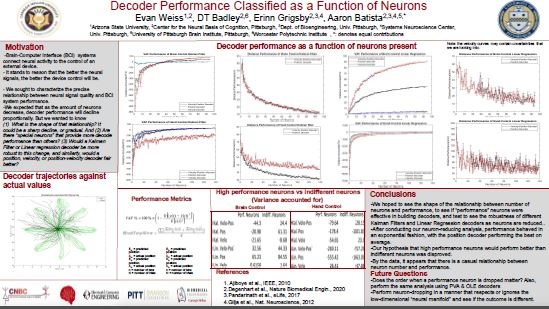 Undergraduate Institution: Worcester Polytechnic Institute
Mentor: Aaron Batista
University and Department: University of Pittsburgh, Bioengineering
Project Description: Brain Computer Interface (BCI) systems connect neural activity to the control of an external device. BCI’s are commonly created with the use of a decoder, which translates neural signals to predictable movements and trajectories. Currently, decoder performance is generally understood as to be proportional to the number of neurons used for calibration. With this assumption Evan Weiss and DT Badley looked to prove that as the number of neurons decreased, the performance would decrease as well. Along with this, they sought to answer what the shape of this curve would look like as well as what decoders were most robust to this change. Next, they wanted to find neurons that were determined to be important for a task by seeing how dropping those neurons caused large performance drops in decoders. After finding these neurons and comparing their performance to the other neurons in the population, they demonstrated that these “performance” neurons did not perform any better than expected. Decoders utilizing more neurons still yielded a higher performance, no matter the classification of the neurons used.
While future work still needs to be done, their results have opened up new questions regarding how characteristics like modulation depth and preferred direction could affect performance neurons results, and how testing specific tasks rather than multiple different tasks could affect the result.
Darryl Badley’s Research Introduction Video
back
Undergraduate Institution: Worcester Polytechnic Institute
Mentor: Aaron Batista
University and Department: University of Pittsburgh, Bioengineering
Project Description: Brain Computer Interface (BCI) systems connect neural activity to the control of an external device. BCI’s are commonly created with the use of a decoder, which translates neural signals to predictable movements and trajectories. Currently, decoder performance is generally understood as to be proportional to the number of neurons used for calibration. With this assumption Evan Weiss and DT Badley looked to prove that as the number of neurons decreased, the performance would decrease as well. Along with this, they sought to answer what the shape of this curve would look like as well as what decoders were most robust to this change. Next, they wanted to find neurons that were determined to be important for a task by seeing how dropping those neurons caused large performance drops in decoders. After finding these neurons and comparing their performance to the other neurons in the population, they demonstrated that these “performance” neurons did not perform any better than expected. Decoders utilizing more neurons still yielded a higher performance, no matter the classification of the neurons used.
While future work still needs to be done, their results have opened up new questions regarding how characteristics like modulation depth and preferred direction could affect performance neurons results, and how testing specific tasks rather than multiple different tasks could affect the result.
Darryl Badley’s Research Introduction Video
back
Esther Bedoyan
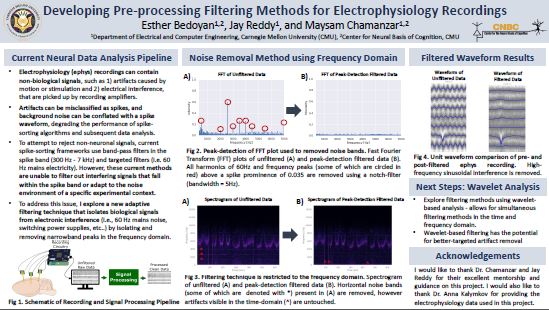 Undergraduate Institution: Carnegie Mellon University
Mentor: Maysam Chamanzar
University and Department: Carnegie Mellon University, Electrical and Computer Engineering
Project Description: With the advent of high throughput neural recording, robust neural data analysis paradigms for electrophysiology (ephys) recordings are now highly-desired. However, ephys recordings are often polluted with non-biological signals which can be conflated with neural spike waveforms. Modern neural data processing pipelines utilize band-pass filters in the spike band (300 Hz – 7 kHz) to maximize the signal-to-noise ratio (SNR) of neural spikes, alongside targeted filters to remove common sources of interference, such as electrical mains current (i.e., 60 Hz and its harmonics). However, these methods are unable to adapt to noise that exists within the spike band and is unique to each experimental setup. In this project, Esther Bedoyan and her mentor explored a new filtering technique adaptable to the unique noise profile of each ephys dataset by isolating biological signals from electronic interference through removal of narrow-band peaks in the frequency domain.
Since the spectral power of neural data is understood to be broadly spread across the spike band, narrow-band peaks within the spike band are likely attributable to artificial sources, such as interference from nearby electronic equipment. Esther designed a filtering technique that first detects narrow-band peaks surpassing a customizable threshold of peak-prominence, defined as height above the background signal, in the Fast Fourier Transform of the ephys data. These identified interference peaks are subsequently removed using notch-filters, and the filtered ephys data is then spike-sorted to produce unit waveforms. This filtering technique was applied to three separate ephys datasets recorded from three-dimensional cortical spheroids with varying noise levels. The background sinusoidal interference present in the spike-sorted unit waveforms was successfully removed from the signals without compromising the neural signal.
Esther Bedoyan’s Research Introduction Video
back
Undergraduate Institution: Carnegie Mellon University
Mentor: Maysam Chamanzar
University and Department: Carnegie Mellon University, Electrical and Computer Engineering
Project Description: With the advent of high throughput neural recording, robust neural data analysis paradigms for electrophysiology (ephys) recordings are now highly-desired. However, ephys recordings are often polluted with non-biological signals which can be conflated with neural spike waveforms. Modern neural data processing pipelines utilize band-pass filters in the spike band (300 Hz – 7 kHz) to maximize the signal-to-noise ratio (SNR) of neural spikes, alongside targeted filters to remove common sources of interference, such as electrical mains current (i.e., 60 Hz and its harmonics). However, these methods are unable to adapt to noise that exists within the spike band and is unique to each experimental setup. In this project, Esther Bedoyan and her mentor explored a new filtering technique adaptable to the unique noise profile of each ephys dataset by isolating biological signals from electronic interference through removal of narrow-band peaks in the frequency domain.
Since the spectral power of neural data is understood to be broadly spread across the spike band, narrow-band peaks within the spike band are likely attributable to artificial sources, such as interference from nearby electronic equipment. Esther designed a filtering technique that first detects narrow-band peaks surpassing a customizable threshold of peak-prominence, defined as height above the background signal, in the Fast Fourier Transform of the ephys data. These identified interference peaks are subsequently removed using notch-filters, and the filtered ephys data is then spike-sorted to produce unit waveforms. This filtering technique was applied to three separate ephys datasets recorded from three-dimensional cortical spheroids with varying noise levels. The background sinusoidal interference present in the spike-sorted unit waveforms was successfully removed from the signals without compromising the neural signal.
Esther Bedoyan’s Research Introduction Video
back
Elizabeth Chamiec-Case
 Undergraduate Institution: University of Connecticut, Storrs
Mentor: Bard Ermentrout
University and Department: University of Pittsburgh, Mathematics
Project Description:A recent paper from Zhang et al. found oscillations in the cortices of surgical patients that, when clustered, give way to propagating alpha and theta waves. The relative phases of the oscillations can show the directionality of the wave’s travel. Elizabeth Chamiec-Case and her mentor first used the Wilson-Cowan equations to model similar waves in the primary visual cortex with variance in frequencies driving wave generation.
Davis et al. from the Salk Institute for Biological Studies recently asked why identical, faint visual stimuli are inconsistently detected. Recording from the visual cortex of marmosets, the probability of firing, and therefore the detection of a stimulus, could be estimated based on the phase of the wave just before the onset of the stimulus and its correlation to a voltage above a calculated threshold. We modeled this phenomenon using a single oscillation in a layer 2 or 3 cortical network and setting a minimum response strength for detection to show, based on simulation trials, that the phase of the oscillation determines the likelihood of stimulus detection.
Elizabeth Chamiec-Case’s Research Introduction Video
back
Undergraduate Institution: University of Connecticut, Storrs
Mentor: Bard Ermentrout
University and Department: University of Pittsburgh, Mathematics
Project Description:A recent paper from Zhang et al. found oscillations in the cortices of surgical patients that, when clustered, give way to propagating alpha and theta waves. The relative phases of the oscillations can show the directionality of the wave’s travel. Elizabeth Chamiec-Case and her mentor first used the Wilson-Cowan equations to model similar waves in the primary visual cortex with variance in frequencies driving wave generation.
Davis et al. from the Salk Institute for Biological Studies recently asked why identical, faint visual stimuli are inconsistently detected. Recording from the visual cortex of marmosets, the probability of firing, and therefore the detection of a stimulus, could be estimated based on the phase of the wave just before the onset of the stimulus and its correlation to a voltage above a calculated threshold. We modeled this phenomenon using a single oscillation in a layer 2 or 3 cortical network and setting a minimum response strength for detection to show, based on simulation trials, that the phase of the oscillation determines the likelihood of stimulus detection.
Elizabeth Chamiec-Case’s Research Introduction Video
back
Hannah Douglas
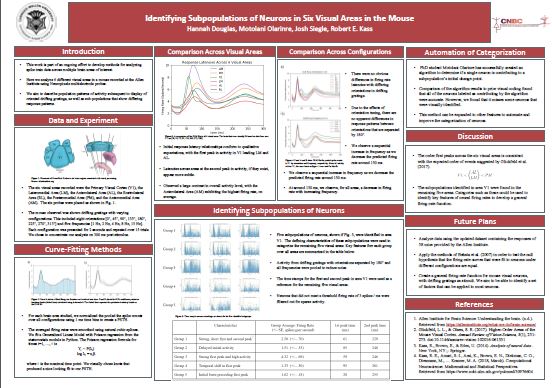 Undergraduate Institution: Carnegie Mellon University
Mentor: Robert Kass
University and Department: Carnegie Mellon University, Statistics & Data Science and Machine Learning
Project Description: Neural spiking activity was recorded, using Neuropixels (Jun et al., Nature, 2017), from more than 100 neurons in each of 6 brain regions, simultaneously, in response to visual stimuli, by the lab of Dr. Joshua Siegle at the Allen Institute for Brain Science. Each mouse was presented with drifting gratings under varying conditions (8 orientations and 5 frequencies), for 2 seconds, with 15 replications, leading to a total of 600 trials. We are interested in the extent to which neural activity across regions appears to be coordinated in response to stimuli. For example, shortly after a stimulus appears, activity in V1 may increase and be followed by activity in other visual regions. Suitable statistical analysis should reveal such patterns of activity on a trial-by-trial basis. However, the neurons in each region are inhomogeneous. Hannah Douglas’ project aims to identify sub-populations of neurons, in each region, that respond similarly to each other but differently than those in other sub-populations. We use descriptive methods to illustrate inhomogeneity, and we apply statistical inference procedures to demonstrate correlated activity, among selected sub-populations, across regions.
Hannah Douglas’s Research Introduction Video
back
Undergraduate Institution: Carnegie Mellon University
Mentor: Robert Kass
University and Department: Carnegie Mellon University, Statistics & Data Science and Machine Learning
Project Description: Neural spiking activity was recorded, using Neuropixels (Jun et al., Nature, 2017), from more than 100 neurons in each of 6 brain regions, simultaneously, in response to visual stimuli, by the lab of Dr. Joshua Siegle at the Allen Institute for Brain Science. Each mouse was presented with drifting gratings under varying conditions (8 orientations and 5 frequencies), for 2 seconds, with 15 replications, leading to a total of 600 trials. We are interested in the extent to which neural activity across regions appears to be coordinated in response to stimuli. For example, shortly after a stimulus appears, activity in V1 may increase and be followed by activity in other visual regions. Suitable statistical analysis should reveal such patterns of activity on a trial-by-trial basis. However, the neurons in each region are inhomogeneous. Hannah Douglas’ project aims to identify sub-populations of neurons, in each region, that respond similarly to each other but differently than those in other sub-populations. We use descriptive methods to illustrate inhomogeneity, and we apply statistical inference procedures to demonstrate correlated activity, among selected sub-populations, across regions.
Hannah Douglas’s Research Introduction Video
back
Noah Hillman
 Undergraduate Institution: St. Olaf College
Mentor: David Danks
University and Department: Carnegie Mellon University, Philosophy
Project Description: Throughout the years, numerous causal learning models have been developed in an attempt to predict and explain how individuals make inferences about the relationship between a cue and subsequent effect. However, the vast majority of these models have been validated on data that has been averaged across subjects, thereby failing to account for the variation known to exist in individual’s causal learning strategies. Laila Johnston’s and Noah Hillman’s project examined individual variation in causal learning by determining, for each individual in experiments from Danks & Schwartz (2005, 2006), which causal learning model best describes that individual’s causal ratings. Furthermore, this study considers not only prominent models from the scientific literature, but also includes novel models which were developed in order to account for deficiencies in prevailing methodologies. Overall, we found that the expanded causal power theories exceeded all other causal learning models in prediction accuracy. In the future, we aim to investigate the stability of causal learning strategies within individuals across experimental conditions, as well as the overlap in the prediction space of various causal learning models.
Noah Hillman’s Research Introduction Video
back
Undergraduate Institution: St. Olaf College
Mentor: David Danks
University and Department: Carnegie Mellon University, Philosophy
Project Description: Throughout the years, numerous causal learning models have been developed in an attempt to predict and explain how individuals make inferences about the relationship between a cue and subsequent effect. However, the vast majority of these models have been validated on data that has been averaged across subjects, thereby failing to account for the variation known to exist in individual’s causal learning strategies. Laila Johnston’s and Noah Hillman’s project examined individual variation in causal learning by determining, for each individual in experiments from Danks & Schwartz (2005, 2006), which causal learning model best describes that individual’s causal ratings. Furthermore, this study considers not only prominent models from the scientific literature, but also includes novel models which were developed in order to account for deficiencies in prevailing methodologies. Overall, we found that the expanded causal power theories exceeded all other causal learning models in prediction accuracy. In the future, we aim to investigate the stability of causal learning strategies within individuals across experimental conditions, as well as the overlap in the prediction space of various causal learning models.
Noah Hillman’s Research Introduction Video
back
Hunsica Jayaprakash
 Undergraduate Institution: University of Pittsburgh
Mentor: Howard Aizenstein
University and Department: University of Pittsburgh, Psychiatry
Project Description: Alzheimer’s disease (AD) is the most common form of dementia. AD is process of progressive neurodegeneration of the brain’s structure and function. This process of neurodegeneration begins years prior to significant cognitive decline and is associated with cerebral beta amyloid (Aβ). This early stage of significant amyloid pathology without overt cognitive dysfunction is known as pre-clinical AD. As cerebral (Aβ) does not deposit symmetrically between the left and right hemispheres, some hypothesize that neurodegeneration would occur asymmetrically. Asymmetry is not always pathological. For example, we know that the language center is more left lateralized in the brain. In AD, asymmetric cortical volume changes are thought to occur due to regional changes such as cerebral (Aβ) deposition, and neurofibrillary tangles (NFTs) amongst others. Due to the increased prevalence of AD and our growing elderly population, it is crucial in understanding potential factors and markers that could prevent or delay AD progression.
In order to study patterns in brain asymmetry and identify potential markers for the prevention of AD, Hunsica Jayaprakash conducted a preclinical AD cross-sectional study. Hunsi computed the Asymmetry Index (AI), a ratio of the left and right hippocampal volume, and calculated the Degree of asymmetry (AI_abs). She conducted multiple linear regression models to examine associations between Asymmetry Index and AD pathological factors. In addition, she ran a hemispheric volumetric analysis to examine associations in the right and left hippocampus with AD pathological factors. It was found that age was negatively associated to both the right and left hippocampal volumes. Unexpectedly, greater cerebral glucose metabolism was associated with right hippocampal volume. Our results demonstrated age-associated lower hippocampal volume and suggested symmetric atrophy changes will cease at some point and transition to asymmetric atrophy. At this later stage during AD progression, cognitive impairment might be present along with lower glucose metabolism, and more asymmetric volume changes.
Hunsica Jayaprakash’s Research Introduction Video
back
Undergraduate Institution: University of Pittsburgh
Mentor: Howard Aizenstein
University and Department: University of Pittsburgh, Psychiatry
Project Description: Alzheimer’s disease (AD) is the most common form of dementia. AD is process of progressive neurodegeneration of the brain’s structure and function. This process of neurodegeneration begins years prior to significant cognitive decline and is associated with cerebral beta amyloid (Aβ). This early stage of significant amyloid pathology without overt cognitive dysfunction is known as pre-clinical AD. As cerebral (Aβ) does not deposit symmetrically between the left and right hemispheres, some hypothesize that neurodegeneration would occur asymmetrically. Asymmetry is not always pathological. For example, we know that the language center is more left lateralized in the brain. In AD, asymmetric cortical volume changes are thought to occur due to regional changes such as cerebral (Aβ) deposition, and neurofibrillary tangles (NFTs) amongst others. Due to the increased prevalence of AD and our growing elderly population, it is crucial in understanding potential factors and markers that could prevent or delay AD progression.
In order to study patterns in brain asymmetry and identify potential markers for the prevention of AD, Hunsica Jayaprakash conducted a preclinical AD cross-sectional study. Hunsi computed the Asymmetry Index (AI), a ratio of the left and right hippocampal volume, and calculated the Degree of asymmetry (AI_abs). She conducted multiple linear regression models to examine associations between Asymmetry Index and AD pathological factors. In addition, she ran a hemispheric volumetric analysis to examine associations in the right and left hippocampus with AD pathological factors. It was found that age was negatively associated to both the right and left hippocampal volumes. Unexpectedly, greater cerebral glucose metabolism was associated with right hippocampal volume. Our results demonstrated age-associated lower hippocampal volume and suggested symmetric atrophy changes will cease at some point and transition to asymmetric atrophy. At this later stage during AD progression, cognitive impairment might be present along with lower glucose metabolism, and more asymmetric volume changes.
Hunsica Jayaprakash’s Research Introduction Video
back
Laila Johnston
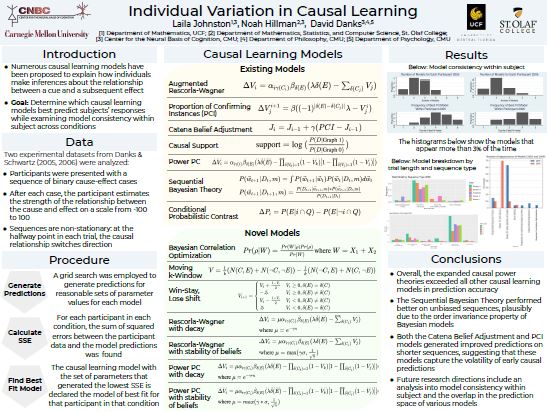 Undergraduate Institution: University of Central Florida
Mentor: David Danks
University and Department: Carnegie Mellon University, Philosophy
Project Description: Throughout the years, numerous causal learning models have been developed in an attempt to predict and explain how individuals make inferences about the relationship between a cue and subsequent effect. However, the vast majority of these models have been validated on data that has been averaged across subjects, thereby failing to account for the variation known to exist in individual’s causal learning strategies. Laila Johnston’s and Noah Hillman’s project examined individual variation in causal learning by determining, for each individual in experiments from Danks & Schwartz (2005, 2006), which causal learning model best describes that individual’s causal ratings. Furthermore, this study considers not only prominent models from the scientific literature, but also includes novel models which were developed in order to account for deficiencies in prevailing methodologies. Overall, we found that the expanded causal power theories exceeded all other causal learning models in prediction accuracy. In the future, we aim to investigate the stability of causal learning strategies within individuals across experimental conditions, as well as the overlap in the prediction space of various causal learning models.
Laila Johnston’s Research Introduction Video
back
Undergraduate Institution: University of Central Florida
Mentor: David Danks
University and Department: Carnegie Mellon University, Philosophy
Project Description: Throughout the years, numerous causal learning models have been developed in an attempt to predict and explain how individuals make inferences about the relationship between a cue and subsequent effect. However, the vast majority of these models have been validated on data that has been averaged across subjects, thereby failing to account for the variation known to exist in individual’s causal learning strategies. Laila Johnston’s and Noah Hillman’s project examined individual variation in causal learning by determining, for each individual in experiments from Danks & Schwartz (2005, 2006), which causal learning model best describes that individual’s causal ratings. Furthermore, this study considers not only prominent models from the scientific literature, but also includes novel models which were developed in order to account for deficiencies in prevailing methodologies. Overall, we found that the expanded causal power theories exceeded all other causal learning models in prediction accuracy. In the future, we aim to investigate the stability of causal learning strategies within individuals across experimental conditions, as well as the overlap in the prediction space of various causal learning models.
Laila Johnston’s Research Introduction Video
back
Lauren Lang
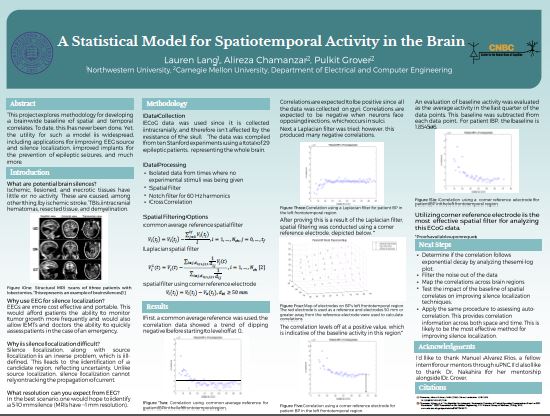 Undergraduate Institution: Northwestern University
Mentor: Pulkit Grover
University and Department: Carnegie Mellon University, Electrical and Computer Engineering
Project Description: Lauren Lang’s project explored methodology for developing a brain-wide baseline of spatial and temporal correlates. To date, this has never been done. Yet, the utility for such a model is widespread, including applications for improving EEG source and silence localization, and much more.
Lauren Lang’s Research Introduction Video
back
Undergraduate Institution: Northwestern University
Mentor: Pulkit Grover
University and Department: Carnegie Mellon University, Electrical and Computer Engineering
Project Description: Lauren Lang’s project explored methodology for developing a brain-wide baseline of spatial and temporal correlates. To date, this has never been done. Yet, the utility for such a model is widespread, including applications for improving EEG source and silence localization, and much more.
Lauren Lang’s Research Introduction Video
back
Claudia Li
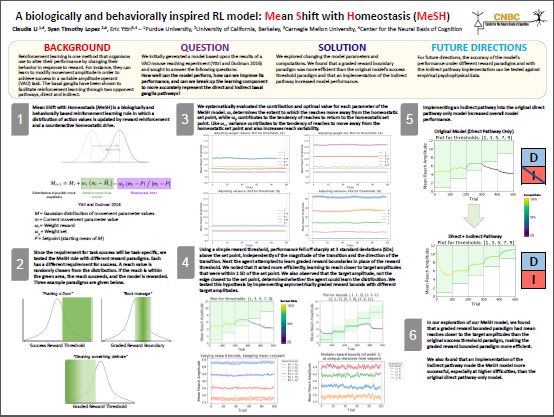 Undergraduate Institution: Purdue University
Mentor: Eric Yttri
University and Department: Carnegie Mellon University, Biological Sciences
Project Description: Reinforcement learning is a vital method organism use to alter their behavior in response to reward. For instance, both mice and humans can learn to modify movement amplitude in order to achieve success in a variable amplitude operant (VAO) task. The basal ganglia have been shown to facilitate reinforcement learning through the opponent direct and indirect pathways. Claudia Li’s and Syan Lopez’ project initially generated a model based upon the results of a VAO mouse reaching experiment (Yttri and Dudman 2016, 2018) and sought to determine and improve the model’s performance. Additionally, we added features to increase the biological plausibility and more accurately represent the direct and indirect basal ganglia pathways. In doing so, we explored changing the model parameters and computations. We found that by altering the reward paradigm from a success threshold to a graded reward boundary, the model performed more efficiently choosing reach amplitudes closer to the target values. We also found that by implementing an additional term in the computation to model the influence of the indirect pathway, we were able to increase model performance which was especially evident at higher reach thresholds.
Claudia Li’s Research Introduction Video
back
Undergraduate Institution: Purdue University
Mentor: Eric Yttri
University and Department: Carnegie Mellon University, Biological Sciences
Project Description: Reinforcement learning is a vital method organism use to alter their behavior in response to reward. For instance, both mice and humans can learn to modify movement amplitude in order to achieve success in a variable amplitude operant (VAO) task. The basal ganglia have been shown to facilitate reinforcement learning through the opponent direct and indirect pathways. Claudia Li’s and Syan Lopez’ project initially generated a model based upon the results of a VAO mouse reaching experiment (Yttri and Dudman 2016, 2018) and sought to determine and improve the model’s performance. Additionally, we added features to increase the biological plausibility and more accurately represent the direct and indirect basal ganglia pathways. In doing so, we explored changing the model parameters and computations. We found that by altering the reward paradigm from a success threshold to a graded reward boundary, the model performed more efficiently choosing reach amplitudes closer to the target values. We also found that by implementing an additional term in the computation to model the influence of the indirect pathway, we were able to increase model performance which was especially evident at higher reach thresholds.
Claudia Li’s Research Introduction Video
back
Syan Lopez
 Undergraduate Institution: University of California, Berkeley
Mentor: Eric Yttri
University and Department: Carnegie Mellon University, Biological Sciences
Project Description:Reinforcement learning is a vital method organism use to alter their behavior in response to reward. For instance, both mice and humans can learn to modify movement amplitude in order to achieve success in a variable amplitude operant (VAO) task. The basal ganglia have been shown to facilitate reinforcement learning through the opponent direct and indirect pathways. Claudia Li’s and Syan Lopez’ project initially generated a model based upon the results of a VAO mouse reaching experiment (Yttri and Dudman 2016, 2018) and sought to determine and improve the model’s performance. Additionally, we added features to increase the biological plausibility and more accurately represent the direct and indirect basal ganglia pathways. In doing so, we explored changing the model parameters and computations. We found that by altering the reward paradigm from a success threshold to a graded reward boundary, the model performed more efficiently choosing reach amplitudes closer to the target values. We also found that by implementing an additional term in the computation to model the influence of the indirect pathway, we were able to increase model performance which was especially evident at higher reach thresholds.
Syan Lopez’s Research Introduction Video
back
Undergraduate Institution: University of California, Berkeley
Mentor: Eric Yttri
University and Department: Carnegie Mellon University, Biological Sciences
Project Description:Reinforcement learning is a vital method organism use to alter their behavior in response to reward. For instance, both mice and humans can learn to modify movement amplitude in order to achieve success in a variable amplitude operant (VAO) task. The basal ganglia have been shown to facilitate reinforcement learning through the opponent direct and indirect pathways. Claudia Li’s and Syan Lopez’ project initially generated a model based upon the results of a VAO mouse reaching experiment (Yttri and Dudman 2016, 2018) and sought to determine and improve the model’s performance. Additionally, we added features to increase the biological plausibility and more accurately represent the direct and indirect basal ganglia pathways. In doing so, we explored changing the model parameters and computations. We found that by altering the reward paradigm from a success threshold to a graded reward boundary, the model performed more efficiently choosing reach amplitudes closer to the target values. We also found that by implementing an additional term in the computation to model the influence of the indirect pathway, we were able to increase model performance which was especially evident at higher reach thresholds.
Syan Lopez’s Research Introduction Video
back
Madelyn McAndrew
 Undergraduate Institution: University of Pittsburgh
Mentor: Srivatsun Sadagopan
University and Department: University of Pittsburgh, Neurobiology
Project Description:
Madelyn McAndrew’s Research Introduction Video
back
Undergraduate Institution: University of Pittsburgh
Mentor: Srivatsun Sadagopan
University and Department: University of Pittsburgh, Neurobiology
Project Description:
Madelyn McAndrew’s Research Introduction Video
back
Harold Rockwell
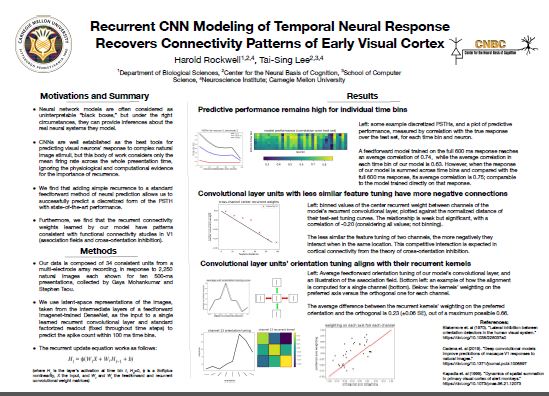 Undergraduate Institution: Carnegie Mellon University
Mentor: Tai-Sing Lee
University and Department: Carnegie Mellon University, Computer Science & The Neuroscience Institute
Project Description: Neural data prediction, dominated by black-box convolutional neural network models, is an established subfield in which predictive models are fit to visual neurons’ response to natural image stimuli. However, the standard approach models only the average firing rate, ignoring the temporal dynamics of the neural response. Hal Rockwell extended this by modeling early visual neurons’ response over time with a recurrent convolutional neural network, verifying that a simple modification to standard models could succeed at this task. Furthermore, he found that the recurrent weights learned by the model match patterns predicted from functional connectivity experiments in early visual areas, specifically those corresponding to cross-orientation inhibition and association fields. This successful “opening up” of the black-box neural network models, replicating expected patterns, suggests that properly constructed predictive models can be used to make novel inferences about recurrent circuitry in early visual cortex.
Harold Rockwell’s Research Introduction Video
back
Undergraduate Institution: Carnegie Mellon University
Mentor: Tai-Sing Lee
University and Department: Carnegie Mellon University, Computer Science & The Neuroscience Institute
Project Description: Neural data prediction, dominated by black-box convolutional neural network models, is an established subfield in which predictive models are fit to visual neurons’ response to natural image stimuli. However, the standard approach models only the average firing rate, ignoring the temporal dynamics of the neural response. Hal Rockwell extended this by modeling early visual neurons’ response over time with a recurrent convolutional neural network, verifying that a simple modification to standard models could succeed at this task. Furthermore, he found that the recurrent weights learned by the model match patterns predicted from functional connectivity experiments in early visual areas, specifically those corresponding to cross-orientation inhibition and association fields. This successful “opening up” of the black-box neural network models, replicating expected patterns, suggests that properly constructed predictive models can be used to make novel inferences about recurrent circuitry in early visual cortex.
Harold Rockwell’s Research Introduction Video
back
Jessica Weber
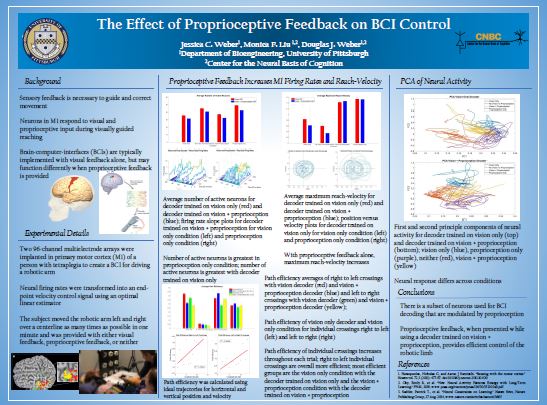 Undergraduate Institution: University of Pittsburgh
Mentor: Doug Weber
University and Department: University of Pittsburgh, Bioengineering
Project Description: Whether a person is reaching for a coffee cup or conducting precise neurosurgery, sensory feedback is necessary to guide and correct movement. Sensory information is multifaceted and complex. Understanding how humans process such rich and complex information will enable the development of better technologies for individuals with spinal cord injury. Two 96-channel multielectrode arrays were implanted in primary motor cortex (M1) of a person with tetraplegia as a result of spinocerebellar degeneration to create a brain computer interface (BCI) for controlling a robotic arm. Neural firing rates were transformed into an end-point velocity control signal using an optimal linear estimator. We examined how visual and proprioceptive feedback were incorporated into BCI control by having the subject move the robotic arm left and right over a centerline as many times as possible in one minute. During this task, the subject was provided with either visual feedback, proprioceptive feedback, or neither.
Jessica Weber primarily investigated the behavioral effects of proprioceptive feedback on BCI control by examining kinematic data. To do so, Jessica created an algorithm to quantify the efficiency of individual crossings during each trial and found that the efficiency of individual crossings increased throughout a single trial and individual crossings from the right to the left were most efficient. When the BCI decoder was trained on vision only, the subject performed the task most efficiently with visual feedback alone, or visual and proprioceptive feedback. When the decoder was trained on vision and proprioception, however, task efficiency was best when both visual and proprioceptive feedback were provided. Furthermore, with proprioceptive feedback alone, the maximum velocity of the robot arm increased, suggesting that a subset of neurons used for BCI decoding are modulated by proprioceptive input.
To further understand the underlying mechanisms of robotic limb control in the presence or absence of visual and proprioceptive input, Jessica used principal components analysis (PCA) to identify specific populations of neurons that are modulated by different sensory feedback modalities. This analysis indicated that the response of neurons in M1 differs across different combinations of visual and proprioceptive feedback.
Jessica’s findings suggest that both visual and proprioceptive feedback are represented in M1 and can be used to help guide and correct movement. This research has shown that, by integrating proprioceptive feedback, BCI control can become more efficient. By understanding the underlying mechanisms of modulations in neural activity due to different sensory feedback modalities, we can correct and improve robotic limb control by optimizing the use of sensory feedback.
Jessica Weber’s Research Introduction Video
back
Undergraduate Institution: University of Pittsburgh
Mentor: Doug Weber
University and Department: University of Pittsburgh, Bioengineering
Project Description: Whether a person is reaching for a coffee cup or conducting precise neurosurgery, sensory feedback is necessary to guide and correct movement. Sensory information is multifaceted and complex. Understanding how humans process such rich and complex information will enable the development of better technologies for individuals with spinal cord injury. Two 96-channel multielectrode arrays were implanted in primary motor cortex (M1) of a person with tetraplegia as a result of spinocerebellar degeneration to create a brain computer interface (BCI) for controlling a robotic arm. Neural firing rates were transformed into an end-point velocity control signal using an optimal linear estimator. We examined how visual and proprioceptive feedback were incorporated into BCI control by having the subject move the robotic arm left and right over a centerline as many times as possible in one minute. During this task, the subject was provided with either visual feedback, proprioceptive feedback, or neither.
Jessica Weber primarily investigated the behavioral effects of proprioceptive feedback on BCI control by examining kinematic data. To do so, Jessica created an algorithm to quantify the efficiency of individual crossings during each trial and found that the efficiency of individual crossings increased throughout a single trial and individual crossings from the right to the left were most efficient. When the BCI decoder was trained on vision only, the subject performed the task most efficiently with visual feedback alone, or visual and proprioceptive feedback. When the decoder was trained on vision and proprioception, however, task efficiency was best when both visual and proprioceptive feedback were provided. Furthermore, with proprioceptive feedback alone, the maximum velocity of the robot arm increased, suggesting that a subset of neurons used for BCI decoding are modulated by proprioceptive input.
To further understand the underlying mechanisms of robotic limb control in the presence or absence of visual and proprioceptive input, Jessica used principal components analysis (PCA) to identify specific populations of neurons that are modulated by different sensory feedback modalities. This analysis indicated that the response of neurons in M1 differs across different combinations of visual and proprioceptive feedback.
Jessica’s findings suggest that both visual and proprioceptive feedback are represented in M1 and can be used to help guide and correct movement. This research has shown that, by integrating proprioceptive feedback, BCI control can become more efficient. By understanding the underlying mechanisms of modulations in neural activity due to different sensory feedback modalities, we can correct and improve robotic limb control by optimizing the use of sensory feedback.
Jessica Weber’s Research Introduction Video
back
Casey Weiner
 Undergraduate Institution: Johns Hopkins University
Mentor: Jonathan Rubin
University and Department: University of Pittsburgh, Mathematics
Project Description: Casey Weiner modeled neurons within the basal ganglia (BG) using a modified two compartment Hodgkin-Huxley system. The computational framework specifically modeled how neurons within the substantia nigra pars reticulata (SNr), the primary output center in the BG of rodents, interpret signals from the globus pallidus (GPe) and the striatum (Str). Both of these regions use GABA inputs, typically thought to be inhibitory, to regulate SNr firing. GPe signals target the soma, while Str inputs arrive at the dendrite, motivating the use of a two-compartment SNr model. Casey looked at the effects of simulating optogenetic GPe and Str stimulation at varying frequencies, which resulted in not just the expected inhibition but four distinct types of responses. These discoveries open questions and avenues of investigation into the biological mechanisms at play in neuronal firing in the BG.
Casey Weiner’s Research Introduction Video
back
Undergraduate Institution: Johns Hopkins University
Mentor: Jonathan Rubin
University and Department: University of Pittsburgh, Mathematics
Project Description: Casey Weiner modeled neurons within the basal ganglia (BG) using a modified two compartment Hodgkin-Huxley system. The computational framework specifically modeled how neurons within the substantia nigra pars reticulata (SNr), the primary output center in the BG of rodents, interpret signals from the globus pallidus (GPe) and the striatum (Str). Both of these regions use GABA inputs, typically thought to be inhibitory, to regulate SNr firing. GPe signals target the soma, while Str inputs arrive at the dendrite, motivating the use of a two-compartment SNr model. Casey looked at the effects of simulating optogenetic GPe and Str stimulation at varying frequencies, which resulted in not just the expected inhibition but four distinct types of responses. These discoveries open questions and avenues of investigation into the biological mechanisms at play in neuronal firing in the BG.
Casey Weiner’s Research Introduction Video
back
Evan Weiss
 Undergraduate Institution: Arizona State University
Mentor: Aaron Batista
University and Department: University of Pittsburgh, Bioengineering
Project Description: Brain Computer Interface (BCI) systems connect neural activity to the control of an external device. BCI’s are commonly created with the use of a decoder, which translates neural signals to predictable movements and trajectories. Currently, decoder performance is generally understood as to be proportional to the number of neurons used for calibration. With this assumption, Evan Weiss and DT Badley looked to identify “special” neurons which in turn could be affecting large performance drops in decoders. Using both Kalman Filters and Linear Regression decoders, they demonstrated that these special neurons may not actually contribute to making a decoder more robust by itself. Decoders utilizing more neurons will still yield a higher performance, no matter the classification of the neurons used. While future work still needs to be done, their results have opened up new questions regarding how individual neurons behave in a decoder, and how characteristics like modulation depth and target angle can dictate performance.
Evan Weiss’s Research Introduction Video
back
Undergraduate Institution: Arizona State University
Mentor: Aaron Batista
University and Department: University of Pittsburgh, Bioengineering
Project Description: Brain Computer Interface (BCI) systems connect neural activity to the control of an external device. BCI’s are commonly created with the use of a decoder, which translates neural signals to predictable movements and trajectories. Currently, decoder performance is generally understood as to be proportional to the number of neurons used for calibration. With this assumption, Evan Weiss and DT Badley looked to identify “special” neurons which in turn could be affecting large performance drops in decoders. Using both Kalman Filters and Linear Regression decoders, they demonstrated that these special neurons may not actually contribute to making a decoder more robust by itself. Decoders utilizing more neurons will still yield a higher performance, no matter the classification of the neurons used. While future work still needs to be done, their results have opened up new questions regarding how individual neurons behave in a decoder, and how characteristics like modulation depth and target angle can dictate performance.
Evan Weiss’s Research Introduction Video
back
